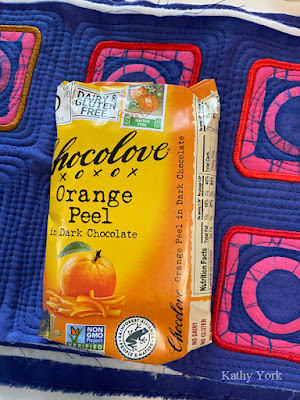Untitled, Part 7
note: In case you are wondering, yes, I do have a couple of titles floating around for this project, I just haven't settled on the right one yet.
Meanwhile:
I was a bit concerned that all the tiny repetitive circular free motion quilting (from the last post) would cause injury to my rotator cuffs. So instead of finishing the quilting on ALL these little pieces, I planned to start the next step at the same time. That way, I could alternate sewing jobs, utilizing different muscles, and hopefully not get a repetitive stress injury.
The next step is satin stitching the blocks. And, I wanted to use as many different color combinations as possible. So, I got out my thread chart samples and I inventoried my supply. I opted to buy a lot of new thread to extend my stash of threads. It was so fun to have them come in!! This selection is mostly Magnifico from Superior Threads.
Also, I knew the back sides of the blocks were going to show, so I wanted the thread color on the back to match the thread color on the front. This also meant I had to buy some more empty bobbins, and fill them as I went. I used some Bottom Line (also from Superior Threads) for the bobbins, mostly because I had such a big stash of Bottom Line and also, it works really great in the bobbins and has excellent color choices!
Here's the part where I tried to decide which thread colors to use for each quilted block, trying to maintain a variety of color combinations. I am also very aware that this many color choices will mean that I need to change the thread in my machine frequently. It can be frustrating to have such a demanding muse!
Let the stitching begin! Something about working with these shiny colorful threads paired with the matte finish of the batik blocks was visually satisfying to me. I enjoyed this phase immensely. It was a lot more fun that quilting in a matching thread color.I also found it easier to turn the quilted pieces under the sewing machine if I trimmed the quilted pages to only 2 squares wide. This will also help out later, for the next round of stitching! Isn't it interesting how the different colors of satin stitching thread make the color of the batik look different? These are all pink batiked squares, but the pinks look different to me depending on the threads surrounding them.
Meanwhile, of note....the satin stitching, especially at the speed I was going, was loud. So, I wore hearing protectors while working. And part way through the project, my sewing machine broke. I had that machine since about 2008, or maybe before then? It was a low end Pfaff, and I bought it just for satin stitching because of all the machines I tested, it performed the best. Now, the presser foot was broken, and it just would not work. I opted to buy a new machine instead of waiting the 5-8 weeks turn-around time for a repair. I also did not know if they would be able to make a repair of this nature and had entered a bizarre world of sewing machine repairs previously with my Juki. I didn't have the heart to go there again. However, I kept my trusty broken Pfaff, thinking I would get it repaired and have a back up, but I haven't done it yet....
The new Pfaff. They don't sell my favorite machine anymore. I was heartbroken. I don't like changes. So, I went on-line, directly to Pfaff, and bought the closest thing they had to my old machine. On the bright side, it came with a needle threader, which I absolutely adore, and it made the numerous thread changes bearable. The day after I bought the machine, it went on sale. Nuts! I called and asked if they would honor the sales price, and refund me the difference? They said YES! Very, very nice of them! Then they sent me a refund for the full price of the machine, and never billed me for the sale price. I tried calling, it took 4 attempts to get through their phone system, but I finally got to speak to a human. I told them what happened and that I still needed to pay for the machine. They thanked me for my honesty, and then, they still never billed me. ??? I really tried to make this right, but ultimately, it didn't happen. So, I got a new free machine, by accident. I would still pay for it, today, if they would give me a way to pay for it.
Back to the project, I enjoyed working my way through the giant pile of quilting, because the satin stitching was my reward! I also require chocolate, from time to time, to help with the motivation for the huge work load. This was my favorite.
























